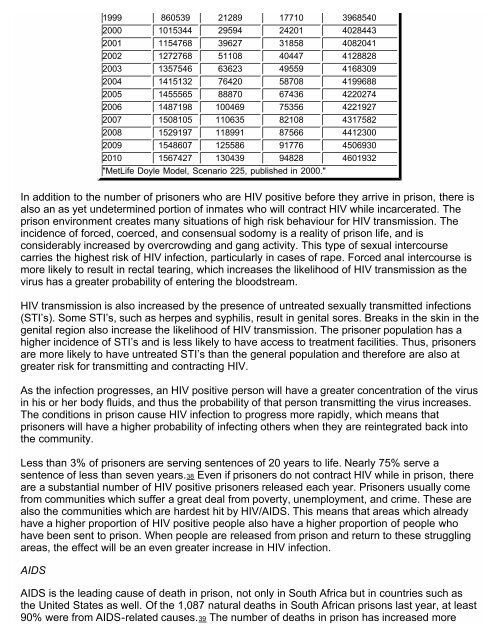prison privatisation in south africa issues, challenges and ...
prison privatisation in south africa issues, challenges and ...
prison privatisation in south africa issues, challenges and ...
Create successful ePaper yourself
Turn your PDF publications into a flip-book with our unique Google optimized e-Paper software.
1999 860539 21289 17710 3968540<br />
2000 1015344 29594 24201 4028443<br />
2001 1154768 39627 31858 4082041<br />
2002 1272768 51108 40447 4128828<br />
2003 1357546 63623 49559 4168309<br />
2004 1415132 76420 58708 4199688<br />
2005 1455565 88870 67436 4220274<br />
2006 1487198 100469 75356 4221927<br />
2007 1508105 110635 82108 4317582<br />
2008 1529197 118991 87566 4412300<br />
2009 1548607 125586 91776 4506930<br />
2010 1567427 130439 94828 4601932<br />
"MetLife Doyle Model, Scenario 225, published <strong>in</strong> 2000."<br />
In addition to the number of <strong>prison</strong>ers who are HIV positive before they arrive <strong>in</strong> <strong>prison</strong>, there is<br />
also an as yet undeterm<strong>in</strong>ed portion of <strong>in</strong>mates who will contract HIV while <strong>in</strong>carcerated. The<br />
<strong>prison</strong> environment creates many situations of high risk behaviour for HIV transmission. The<br />
<strong>in</strong>cidence of forced, coerced, <strong>and</strong> consensual sodomy is a reality of <strong>prison</strong> life, <strong>and</strong> is<br />
considerably <strong>in</strong>creased by overcrowd<strong>in</strong>g <strong>and</strong> gang activity. This type of sexual <strong>in</strong>tercourse<br />
carries the highest risk of HIV <strong>in</strong>fection, particularly <strong>in</strong> cases of rape. Forced anal <strong>in</strong>tercourse is<br />
more likely to result <strong>in</strong> rectal tear<strong>in</strong>g, which <strong>in</strong>creases the likelihood of HIV transmission as the<br />
virus has a greater probability of enter<strong>in</strong>g the bloodstream.<br />
HIV transmission is also <strong>in</strong>creased by the presence of untreated sexually transmitted <strong>in</strong>fections<br />
(STI’s). Some STI’s, such as herpes <strong>and</strong> syphilis, result <strong>in</strong> genital sores. Breaks <strong>in</strong> the sk<strong>in</strong> <strong>in</strong> the<br />
genital region also <strong>in</strong>crease the likelihood of HIV transmission. The <strong>prison</strong>er population has a<br />
higher <strong>in</strong>cidence of STI’s <strong>and</strong> is less likely to have access to treatment facilities. Thus, <strong>prison</strong>ers<br />
are more likely to have untreated STI’s than the general population <strong>and</strong> therefore are also at<br />
greater risk for transmitt<strong>in</strong>g <strong>and</strong> contract<strong>in</strong>g HIV.<br />
As the <strong>in</strong>fection progresses, an HIV positive person will have a greater concentration of the virus<br />
<strong>in</strong> his or her body fluids, <strong>and</strong> thus the probability of that person transmitt<strong>in</strong>g the virus <strong>in</strong>creases.<br />
The conditions <strong>in</strong> <strong>prison</strong> cause HIV <strong>in</strong>fection to progress more rapidly, which means that<br />
<strong>prison</strong>ers will have a higher probability of <strong>in</strong>fect<strong>in</strong>g others when they are re<strong>in</strong>tegrated back <strong>in</strong>to<br />
the community.<br />
Less than 3% of <strong>prison</strong>ers are serv<strong>in</strong>g sentences of 20 years to life. Nearly 75% serve a<br />
sentence of less than seven years.38 Even if <strong>prison</strong>ers do not contract HIV while <strong>in</strong> <strong>prison</strong>, there<br />
are a substantial number of HIV positive <strong>prison</strong>ers released each year. Prisoners usually come<br />
from communities which suffer a great deal from poverty, unemployment, <strong>and</strong> crime. These are<br />
also the communities which are hardest hit by HIV/AIDS. This means that areas which already<br />
have a higher proportion of HIV positive people also have a higher proportion of people who<br />
have been sent to <strong>prison</strong>. When people are released from <strong>prison</strong> <strong>and</strong> return to these struggl<strong>in</strong>g<br />
areas, the effect will be an even greater <strong>in</strong>crease <strong>in</strong> HIV <strong>in</strong>fection.<br />
AIDS<br />
AIDS is the lead<strong>in</strong>g cause of death <strong>in</strong> <strong>prison</strong>, not only <strong>in</strong> South Africa but <strong>in</strong> countries such as<br />
the United States as well. Of the 1,087 natural deaths <strong>in</strong> South African <strong>prison</strong>s last year, at least<br />
90% were from AIDS-related causes.39 The number of deaths <strong>in</strong> <strong>prison</strong> has <strong>in</strong>creased more
















